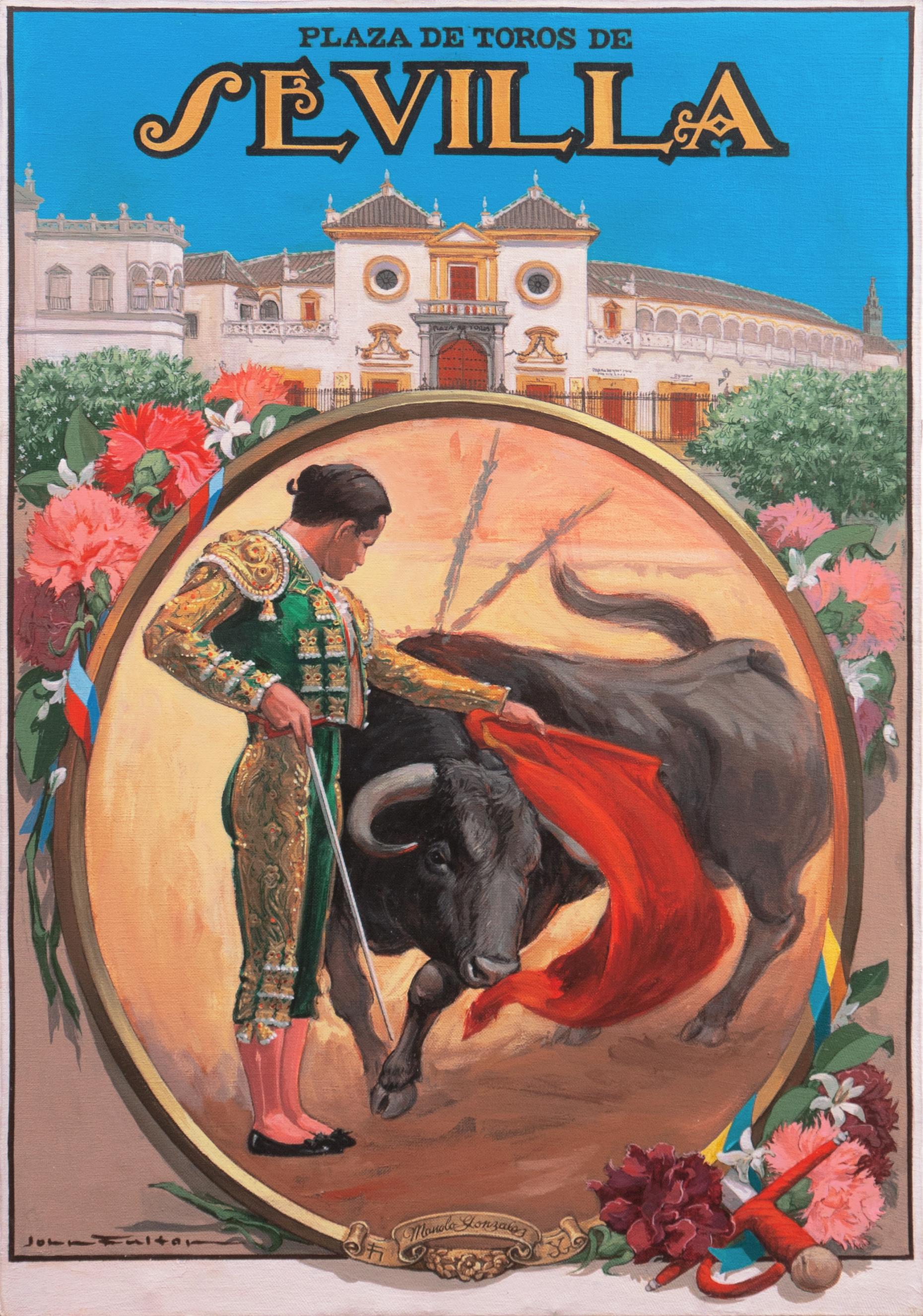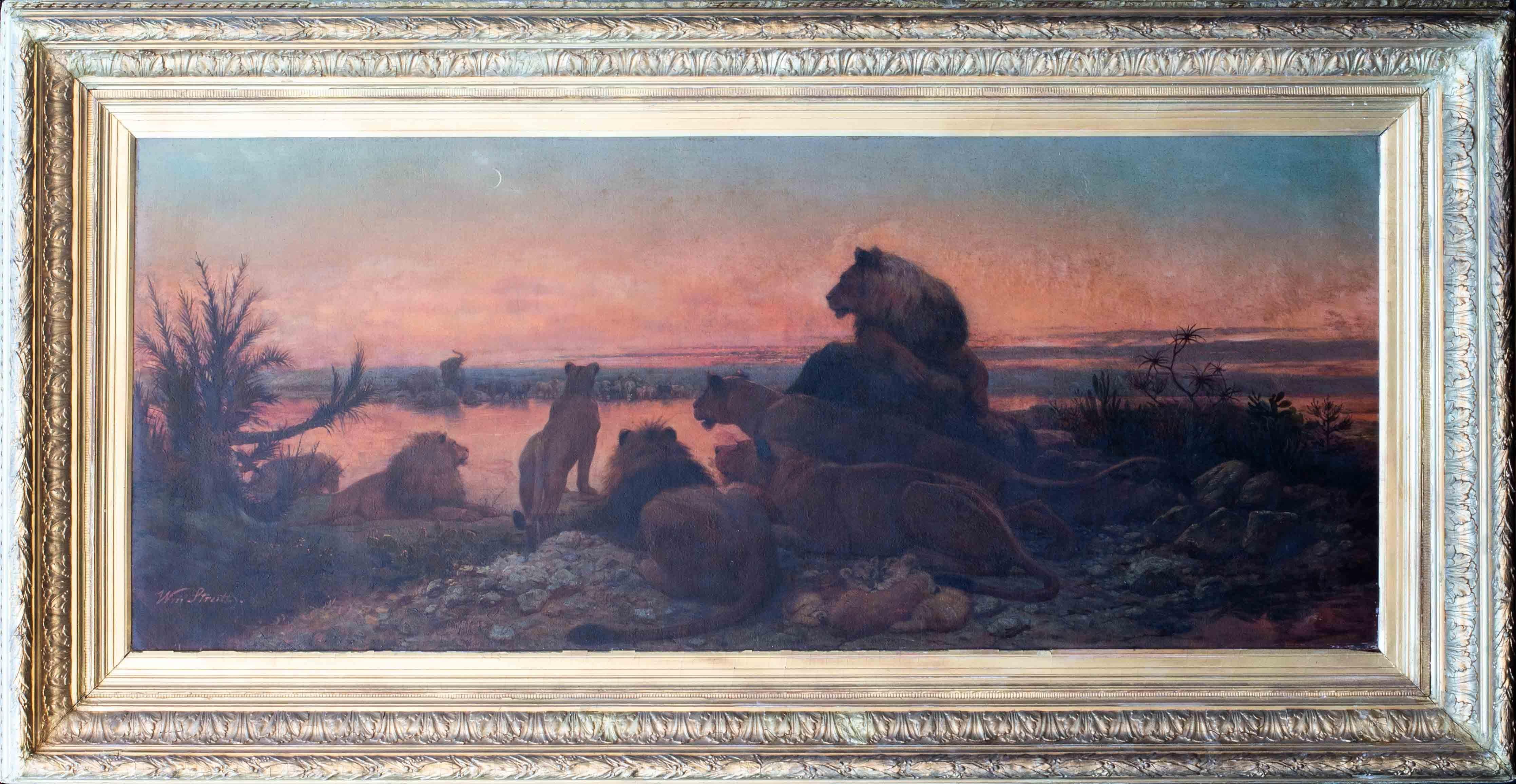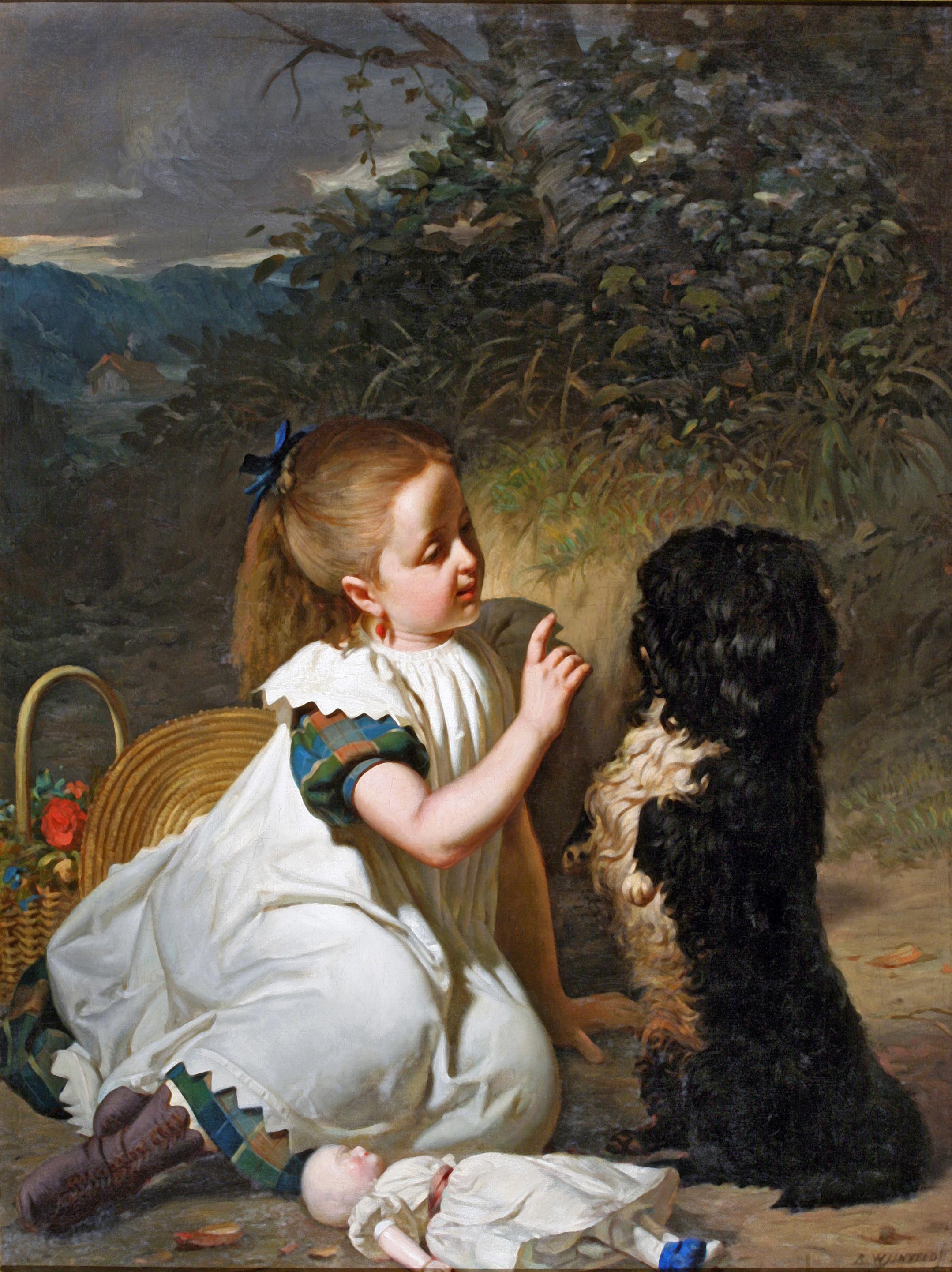Items Similar to Two Borzois by Otto Eerelman
Want more images or videos?
Request additional images or videos from the seller
1 of 6
Otto EerelmanTwo Borzois by Otto Eerelmancirca 1880
circa 1880
About the Item
This monumental painting is by the celebrated Dutch artist Otto Eerelman, one of 19th-century Europe's most popular and important animal portraitists, and this particular work is a triumph of the genre. Painted circa 1880, it features two of Eerelman's favored subjects – large-breed dogs and a meticulously executed Dutch interior. Impeccably painted and almost certainly commissioned by a member of the Dutch nobility, the work possesses the precise detailing and depth of character that are the quintessential components of Eerelman’s output.
In this powerful composition, two majestic Borzois, or Russian Wolfhounds, await their next hunt in a lavishly decorated room, displaying their luxurious coats and regal demeanors. Eerelman mastered the art of depicting not only the dogs’ physical characteristics but also their unique expressions and personalities. His wealthy clientele would bring their pets to his home in The Hague where they would live for a period of time while having their portraits done, allowing for a remarkably true-to-life portrayal. The narrative is simple and stoic, embodying the elegance and grace of the breed as well as the importance of his clientele.
Hailing from Groningen, Netherlands, Eerelman was dubbed the “Northern Rembrandt” during his lifetime. He received his artistic training at the Academy Minerva in Groningen, the Royal Academy of Fine Arts in Antwerp and then private lessons in the studio of the great Lawrence Alma Tadema. He successfully captured the attention of the Dutch court, particularly Princess Wilhelmina, with his meticulous approach to endearing subjects. His artistic contributions were so great and his work so valued in the Netherlands that he was knighted at the age of 80. Eerelman’s paintings have long been coveted on the market for their inherent charm. Other examples of his dog portraits can be found in the Rijksmuseum (Amsterdam), and in 2015, a major retrospective of his work was held at the Museum Nienoord in Leek, Netherlands.
Circa 1880
Canvas: 52 1/2" high x 68 1/4" wide
Frame: 69 3/4" high x 85 5/8" wide
- Creator:Otto Eerelman (1839 - 1926, Dutch)
- Creation Year:circa 1880
- Dimensions:Height: 69.75 in (177.17 cm)Width: 85.63 in (217.51 cm)
- Medium:
- Movement & Style:
- Period:
- Condition:
- Gallery Location:New Orleans, LA
- Reference Number:
Otto Eerelman
Otto Eerelman (Groningen, March 23, 1839 – Groningen, October 3, 1926) was a painter, etcher and lithographer who is best known for his realistic sketches and paintings of dogs and horses. As a court painter, he also produced various portraits of Princess Wilhelmina in her early years and later as Queen. In addition to the various paintings that Eerelman made for the royal family, such as a portrait of the nurse Evertje Schouten, a painting of eight-year-old Wilhelmina dressed in a white Amazonian suit and depicted with her pony "Baby" (perhaps best known for the depicted Oranjes ), some other works have also become known to a wide audience.
About the Seller
5.0
Vetted Seller
These experienced sellers undergo a comprehensive evaluation by our team of in-house experts.
Established in 1912
1stDibs seller since 2013
15 sales on 1stDibs
Typical response time: 4 hours
- ShippingRetrieving quote...Ships From: New Orleans, LA
- Return PolicyThis item cannot be returned.
More From This SellerView All
- Les Buissons Ardents By André BrasilierBy André BrasilierLocated in New Orleans, LAAndré Brasilier b. 1929 French Les buisson ardents Signed “André Brasilier” (lower right); signed, dated and inscribed "Pour Alexis. Mai 1982" (en verso) Oil on canvas Swirling w...Category
20th Century Post-Impressionist Landscape Paintings
MaterialsOil, Canvas
- Dance of the NymphsBy Paul Desire TrouillebertLocated in New Orleans, LAThis lyrical landscape entitled Dance of the Nymphs was composed by the French Barbizon painter Paul Désiré Trouillebert. A joyful scene of nymphs dancing the morning fog, the work closely resembles an important work by the great Camille Corot, which is now housed at the Musée d'Orsay (Paris). Renowned for his unique individuality that toed the line between the traditional and modern, Corot and his landscapes helped pave the way for an entire generation of Impressionists who followed him. Trouillebert perfectly captures the poetic atmosphere of Corot’s groundbreaking works, while also imbuing this scene with a freshness and character that is all his own. Trouillebert's oil on canvas is exemplary of the tradition of historical painting. The work perfectly combines a realistic depiction of the natural world with a spirited romanticism as his idealized nymph figures frolic playfully beneath a crisp morning sky. As a whole, it is a lovely composition executed with a level of skill and artistry that proves Trouillebert's exceptional talent in the arts. Born in Paris in 1831, Paul Désiré Trouillebert was a student of the academic painters Ernest Hébert...Category
19th Century Academic Landscape Paintings
MaterialsCanvas, Oil
- The Battle Of Copenhagen By John Stevens DewsBy John Steven DewsLocated in New Orleans, LAJohn Steven Dews b.1949 | British The Bombardment of Copenhagen Signed "J Steven Dews" (lower left) Oil on canvas This masterpiece by John Dues, entitled The Bombardment of Copenh...Category
21st Century and Contemporary Academic Landscape Paintings
MaterialsCanvas, Oil
- Portrait Of Horatio Nelson Attributed To Lemuel AbbottLocated in New Orleans, LAAttributed to Lemuel Abbott 1760-1803 | English Portrait of Horatio Nelson Oil on canvas This previously unknown portrait is an important discovery in British Naval history. In Admiral Lord Nelson's illustrious and well-studied life, there existed a "silent period" spanning 16 years during which no known portraits of Nelson existed. The discovery of this 1790 portrait, rendered just before his reentry into the Navy, is a significant development for Nelson scholars, adding new insight into the leader's life prior to his legendary command as Admiral of the British Navy. Almost certainly painted by Lemuel Abbott, the official portraitist of Admiral Nelson, the rendering depicts the naval titan in casual dress. This is one of the two final depictions of Nelson before he acquired the war-inflicted injuries that marked his later years. In 1790, Britain was at peace, and Lord Nelson found himself residing in Burnham Thorpe with his newlywed wife, Frances. Having served with great distinction in South America and the West Indies, he garnered much local acclaim. Yet, the uncertainty of returning to the sea weighed heavily on his mind. At the age of thirty, he lived the life of a country gentleman managing his estate. Only one other much smaller portrait of Nelson in civilian attire exists, a much smaller rendering from 1800 currently held at the National Portrait Gallery. Compelling and atmospheric, the oil on canvas offers viewers a rare glimpse into the visage of a youthful and resolute Nelson, a man driven by an unwavering desire to forge his reputation in the art of naval warfare. This portrait had long been believed by the Nelson family to portray Edmund Nelson, Horatio Nelson's father. When connoisseur Jeremy Knight acquired this treasure directly from the Nelson family, he postulated that the work actually depicted the famed Admiral and not his father, as it was painted around 1790, and the elder Edmund Nelson would have been 68 years old at that time. Knight then hired the renowned Nelson scholar Martin Downer, the former Sotheby's expert and author of the bestselling books Nelson's Purse and Nelson's Lost Jewel, to confirm his hunch. It has now been confirmed by Martin Downer that this portrait is the missing...Category
18th Century Academic Portrait Paintings
MaterialsCanvas, Oil
- SolitudeBy Guillaume SeignacLocated in New Orleans, LAFrench Academic painter Guillaume Seignac was renowned for his masterful treatment of the idealized nude. His languishing female subjects based on Greco-Roman prototypes were and rem...Category
19th Century Academic Nude Paintings
MaterialsOil, Canvas
- Onward - The Norman Court by Montague DawsonBy Montague DawsonLocated in New Orleans, LAMontague Dawson 1890-1973 British Onward - The Norman Court Signed “Montague Dawson” (lower left) Oil on canvas The dynamism of the seas and the might of the clipper ships that brave their waters are captured with great accuracy and attention to detail in this monumental work by Montague Dawson. Here, the artist brings vividly to life the historic clipper ship Norman Court as it battles the waves on the open sea. Dawson, arguably the most important maritime painter of his generation, possessed an incomparable talent for rendering ships at sea with unparalleled energy and vitality. The speed and grace of these historic ships is perfectly realized in the present work, enhanced by Dawson's mastery over composition and the large scale of the painting. Built and launched in 1869 by A. & J. Inglis of Glasgow, Norman Court was a composite clipper ship that traveled between the United Kingdom and East Asia under the command of Andrew Shewan and his son, also named Andrew Shewan. While returning from Java to Glasgow carrying sugar, Norman Court's career was cut short in March of 1883 when a powerful gale caused the ship to be wrecked on the rocks of Cymyran Bay, between the villages of Rhoscolyn and Rhosneigr in Wales. Dawson's immersive composition captures the ship at full sail and the height of her glory, battling the white-capped waves on a brilliant day at sea. The son of a keen yachtsman and grandson of marine painter Henry Dawson, Montague Dawson spent much of his childhood on the Southampton Water, where he was able to indulge his interest in the study of ships. Naturally gifted at drawing and painting, the self-taught Dawson became a member of an art studio group in Bedford Row...Category
Early 20th Century Academic Landscape Paintings
MaterialsCanvas, Oil
You May Also Like
- 'Manolo Gonzalez' Plaza de Toros, Maestranza, Seville, Bullfighting, MatadorLocated in Santa Cruz, CASigned lower left, 'John Fulton' (American, 1933-1998) and painted circa 1995. The original oil painting for the poster advertising the appearance of Manolo Gonzalez at the prestigious Maestranza bullring in Seville and showing famous bullfighter in an emerald suit of lights, holding his espada at the ready while deflecting the enraged bull with his red cape. John Fulton was an American bullfighter and painter who settled in Seville. Born in Philadelphia, he received a scholarship to an art school in San Miguel de Allende, Mexico, in the early 1950s. During this time, he studied both painting and bullfighting, killing his first calf there in 1953. In 1954, Fulton joined the U.S. Army and continued and continued painting and bullfighting on his downtime. After his release in 1956, he moved to Spain where he studied bullfighting under Juan Belmonte and performed as a novillero (novice) with some of Spain’s leading matadors. In July 1963, Fulton was sponsored by José María Montilla to take his 'alternativa' at the Plaza de toros...Category
1990s Academic Portrait Paintings
MaterialsOil, Canvas
- Normandy Rouen Cathedral 19th Century LandscapeBy LangloisLocated in Paris, FRCharming impressionist oil on canvas from the late 19th century representing a view of a quay in Rouen on the Seine with a herd on pasture and Rouen Cathedral...Category
19th Century Academic Landscape Paintings
MaterialsCanvas, Oil
- Three Bucks in the Fontainebleu ForestBy Rosa BonheurLocated in Miami, FLRosa Bonheur was the most famous female artist of the 19th Century. We are grateful to Annie-Paule Quinsac for confirming the authenticity of this painting. The work is best viewed with top gallery light to bring out colors ____________________________________________ Rosa Bonheur: Three Bucks in the Fontainebleau Forest, erroneously Stags or Monarchs in the forest Oil on canvas, 29 x 24 inches [74 x 61cm], signed and dated lower left, Rosa Bonheur 1886 The discovery of this painting, a reinterpretation of Bonheur’s most iconic work Le roi de la Foret, [Monarch in the forest]is a significant event in the artist’s scholarship. In forty years of study, I was not aware of its existence and did not find any reproduction of it throughout my extensive reading. Bought by the present owner at the Stamford Winter Auction in 2008, it had been the property of a certain Captain [ name illegible] until January 29, 1920, or from that date {?}. The label on the back of the canvas reads: “Collection of Captain J.H.Gaucis Jan.29,1920”. [the handwriting on the label is extremely unusual; my deciphering of it induces me to propose this last name, Latvian in origin] […] This work could not have been offered among the 95 paintings that compose the catalog section titled “Stags, Hinds, Roebucks,” [ NN.320-415] in the catalog of the Rosa Bonheur Posthumous Sale organized by the Galerie Georges Petit in Paris, which included over two thousand pieces kept in the studio and not sold during her life time : it does not correspond to any of the description or measurements given in these catalog entries. The number 5527inscribed in red on the back of the canvas could refer to the painting having be handled by the Knoedler Galerie, Paris and New York, which after Bonheur’s death, that of Ernest Gambart (1814-1902and George Petit, (1856-1920) was instrumental in the continued diffusion of her work in the US, maintaining her prices that had crashed elsewhere in Europe. Despite difficulties in tracing the provenance history, the attribution to Rosa Bonheur, cannot be denied. Stylistic and iconographic characters are typical of her expressive means in the late 80’s. Also, it cannot be questioned that the calligraphy of signature and date is hers. The work depicts three male deers- or bucks- of different age, in a trail, deep in the forest at twilight, just after sunset toward the end of Fall. The two big ones, have stopped in their track, facing the beholder frontally; the small one, in profile, seems ready to move in another direction. The umbrella term deer, or the more specific one buck {male deer} could both be used as title to this painting, rather than stag, which implies an old majestic senior male deer, considered the King of the forest also called Monarch. In the Cervidae family, the number of points of a deer’s antler is one of the indicators of age, along with body mass and overall size. In our painting, the most prominent stag is massive and has a twelve points antler – qualifying as Monarch. The one immediately behind him exhibits an eight points antler and appears strong and imposing as well does not possess but not his companion’s poise. It is a mature stag. The last one, slender, shoulders not quite muscular yet, with barely six points to his antler, could not be more than two years old. The intensity of expression of the two older stags and their presence in the landscape which is rendered as their stage, are characteristic of Bonheur’s rapport to animals and nature. The painting’s varnish has deteriorated and forms a film that will need to be removed through a cautious cleaning. It is particularly important that the transparent haze that evokes the humidity of the forest at that crucial moment of the light be preserved. It contributes to the painting vibrance. Since 1860, when Rosa Bonheur moved to the Chateau of By, which she had bought with her companion Nathalie Micas, the Fontainebleau Forest which was at a stone through of her property, became ground of studies and the Cervidae a common subject. By then, she would already sketch en plein air, and months or years later, create paintings from start to finish in the studio using the visual material collected while walking through nature or observing animal in their milieu. Her first image of the Great Monarch in the forest, represented frontally and in a similar forest background is the 1868 painting Le cerf de Saint Hubert [Hubertus’ Stag], an illustration of the legend of Saint Hubertus in which she included a cross between the stag’s antlers. As the story as it, Hubertus was a passionate hunter and would often forget his religious duties to go hunting. On a certain Sunday in the depth of a forest, where he had ventured alone, he began to pursue a stag The animal faced him and while a cross appeared between his antlers, the voice of God was heard, directing him to repent ad respect all animals. Rosa Bonheur was herself a hunter but also a spiritualist, influenced by the Saint Simonian creeds and by spiritism. She believed that certain animals had a soul. I personally think that magnificent monarchs and the St Hubertus...Category
1880s Academic Animal Paintings
MaterialsOil, Canvas
- Large 19th Century oil painting of lions, elephants and zebras at watering holeLocated in Petworth, West SussexA magnificent oil painting of grand proportions by the great British academic artist William Strutt RBA FZS of lions, elephants and zebras at a watering hole. William Strutt RBA FZS...Category
19th Century Academic Animal Paintings
MaterialsCanvas, Oil
- Teaching him a New TrickLocated in Washington, DC19th Century DutchCategory
1890s Academic Figurative Paintings
MaterialsCanvas, Oil
- Sitting Pretty (Pomeranian Pups)By Horatio Henry CoulderyLocated in Washington, DCSigned and dated '1901' lower leftCategory
Early 1900s Academic Animal Paintings
MaterialsCanvas, Oil
Recently Viewed
View AllRead More
Wear Louis Comfort Tiffany’s Genius on Your Finger with This Vivid Ring
In his jewelry making, the designer rarely used diamonds — this rare example has two.
You Won’t Find a More Handsome Stopwatch Than This 1890s Pocket Chronograph
A Grand Complication from the golden era of pocket watches, the Marius Lecoultre pocket watch does everything but uncork your wine.
More Ways To Browse
Antique Animal Paintings Large
Monumental Painting Antique
Royal Knight
Animal Oil Painting Dutch
Regal Painting
European Hunt
Monumental Antique Oil Painting
Large Dog Portrait
19th Century Russian Portrait
Hunt Dog
Fine Art Oil Paintings Dogs
Princess Charm
Dog Painting Oil Interior
Minerva Painting
Antique Dog Charm
Dog Dutch Painting
Antique Oil Portrait Of Dogs
Large 19th Century Dog Painting






